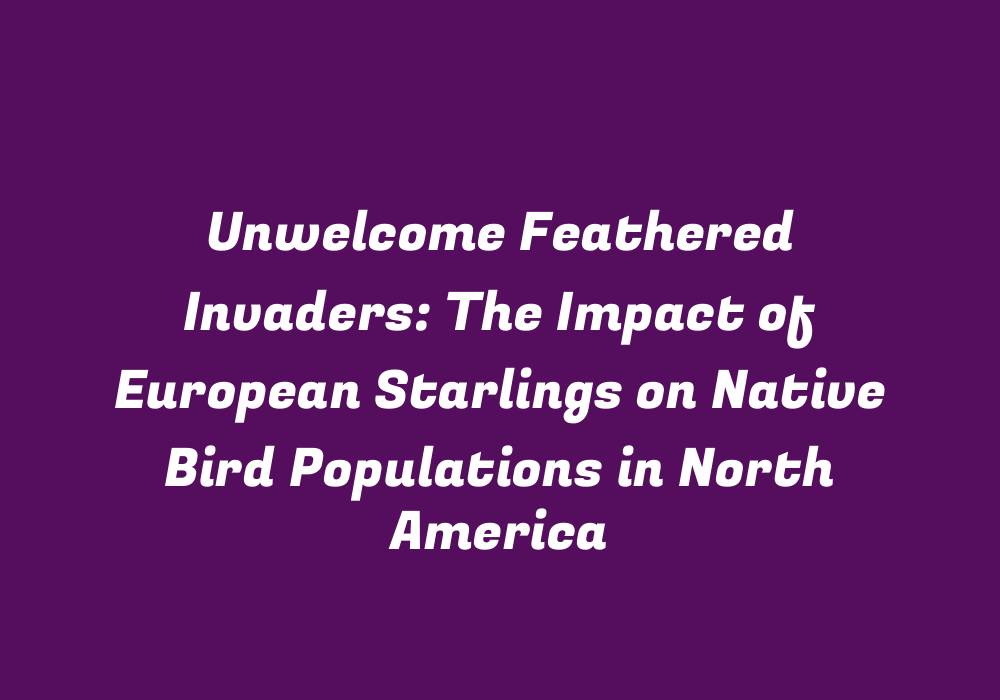Unwelcome Feathered Invaders: The Impact of European Starlings on Native Bird Populations in North America
The arrival of the European Starling (Sturnus vulgaris) in North America during the late 1800s has had a significant impact on the continent’s avian ecosystem. Despite their charming appearance, these birds are considered invasive species due to their detrimental effects on native bird populations and the environment. The European Starling’s introduction, which occurred through deliberate attempts by humans to establish this attractive yet problematic bird in North America, has led to a continuous decline of several native species.
The History of Starlings in North America
In 1890, the American Acclimatization Society – a group that advocated for the introduction of exotic birds and animals from other countries to enrich America’s wildlife – began releasing European Starlings. The intention was to establish a beautiful bird species that would be admired by the public. However, this attempt backfired as the starlings adapted quickly to their new environment and rapidly multiplied. By 1974, they had spread across every contiguous state in America.
Competition for Resources
One of the primary reasons for European Starlings being considered an invasive species is their competition with native bird populations for limited resources. They feed on seeds, fruits, and insects, which are vital food sources for several other birds, including songbirds, robins, and warblers.
Starlings have a broad diet and can consume up to 20 different types of foods in one day. This adaptability allows them to outcompete native birds, especially during breeding seasons when food resources are limited. By taking over nesting sites and feeding grounds, starlings displace native bird species from their habitats.
Negative Impacts on Breeding and Nesting Habits
Another significant issue is the impact of European Starlings on the reproductive habits of native birds. Their aggressive behavior towards other species during nest construction, egg laying, and brooding often leads to a decline in the survival rate of native bird populations. By destroying or stealing nests, starlings can prevent breeding for several species that rely on cavities in trees or man-made structures.
Negative Impacts on Bird Populations
The proliferation of European Starlings has led to a decline in native bird populations throughout North America. Researchers have reported a 76% decrease in the number of breeding cavity-nesting birds and a 10-38% drop in insectivorous songbirds, such as warblers, thrushes, and tanagers.
As more European Starlings continue to thrive in North America, their negative impact on native bird populations increases. They have been known to compete with birds of conservation concern, including the endangered Kirtland’s Warbler. The presence of European Starlings has also led to an increase in parasites like lice and ticks, affecting other species that share their habitat.
Increased Spread of Diseases
European Starlings are known to carry various pathogens that can affect both human and non-human populations. These diseases have the potential to spread among native birds, threatening their wellbeing and potentially causing outbreaks in other species. Additionally, some researchers have linked European Starling populations with West Nile virus outbreaks by serving as a vector for mosquitoes carrying the disease.
Control Measures
Despite their negative impacts on native bird populations and ecosystems, efforts to control or eradicate European Starlings have been limited due to legal restrictions. The Migratory Bird Treaty Act of 1918 protects all species of birds in North America, including the invasive European Starling. However, some states and conservation organizations have developed strategies to manage starling populations through trapping, hunting, and habitat management programs.
Conclusion
The introduction of European Starlings into North America has led to significant challenges for native bird species. As a result, many of these birds face threats from competition for resources, reduced reproductive success, and the spread of diseases. The need for effective control measures remains high, despite legal limitations. Educating the public about the consequences of non-native species introductions is crucial in addressing the challenges presented by invasive European Starlings and protecting our native bird populations.
References
- European Starlings Threaten Native Birds, Study Finds.
- Competition between European Starlings and Native Cavity-Nesting Birds: Implications for Invasive Species Management.
- European Starlings: Ecological Consequences and Control Options.
- European Starlings – Invasive Species and Their Impacts on North American Forests.
- Effects of Invasive European Starlings on North American Bird Populations.
